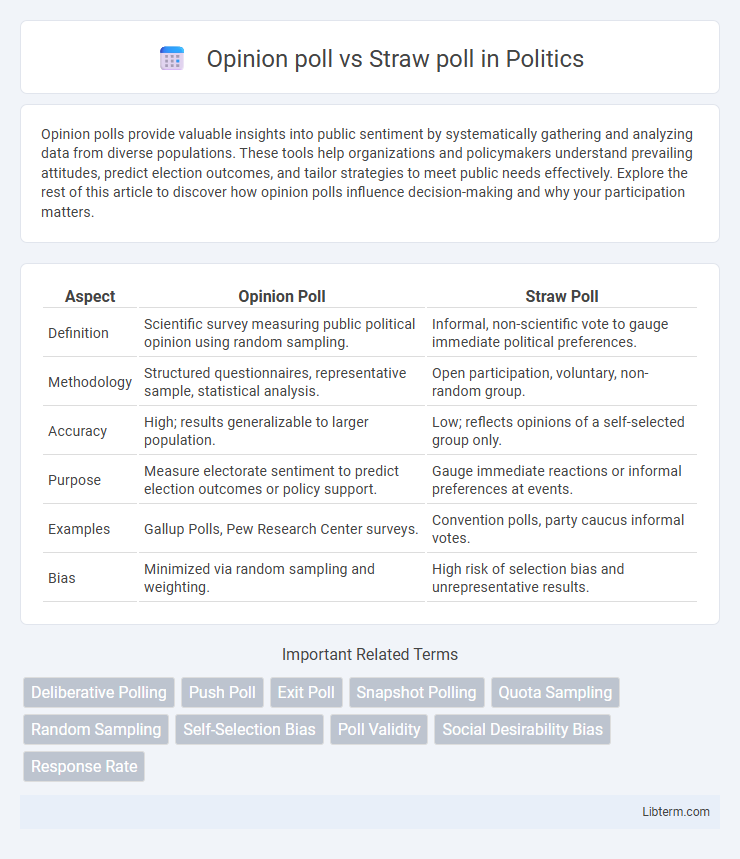Opinion polls provide valuable insights into public sentiment by systematically gathering and analyzing data from diverse populations. These tools help organizations and policymakers understand prevailing attitudes, predict election outcomes, and tailor strategies to meet public needs effectively. Explore the rest of this article to discover how opinion polls influence decision-making and why your participation matters.
Table of Comparison
| Aspect | Opinion Poll | Straw Poll |
|---|---|---|
| Definition | Scientific survey measuring public political opinion using random sampling. | Informal, non-scientific vote to gauge immediate political preferences. |
| Methodology | Structured questionnaires, representative sample, statistical analysis. | Open participation, voluntary, non-random group. |
| Accuracy | High; results generalizable to larger population. | Low; reflects opinions of a self-selected group only. |
| Purpose | Measure electorate sentiment to predict election outcomes or policy support. | Gauge immediate reactions or informal preferences at events. |
| Examples | Gallup Polls, Pew Research Center surveys. | Convention polls, party caucus informal votes. |
| Bias | Minimized via random sampling and weighting. | High risk of selection bias and unrepresentative results. |
Introduction to Opinion Polls and Straw Polls
Opinion polls gather statistically representative data from a randomized sample to predict public opinion on political, social, or market issues, providing reliable insights with quantified margins of error. Straw polls are informal surveys conducted among a non-random group, often within specific events or gatherings, to gauge the immediate preferences or opinions without scientific rigor. While opinion polls emphasize methodological precision and generalizability, straw polls prioritize quick feedback and direct participant input.
Defining Opinion Polls
Opinion polls are systematic surveys designed to measure public attitudes and opinions using statistically representative sample sizes to ensure accuracy and reliability. These polls employ randomized sampling techniques and structured questionnaires to gather quantifiable data, reflecting the broader population's views. Unlike straw polls, opinion polls provide scientifically valid insights that guide decision-making in politics, marketing, and social research.
Understanding Straw Polls
Straw polls are informal surveys used to gauge preliminary opinions or predict trends within a specific group, often lacking scientific sampling methods and failing to represent the wider population accurately. Unlike opinion polls, which employ structured methodologies and statistical techniques to ensure reliability and validity, straw polls provide quick, non-binding insights that can influence decision-making in political or organizational contexts. Understanding straw polls involves recognizing their limitations in accuracy and their role as snapshots of current sentiment rather than definitive public opinion measurements.
Methodology: How Opinion Polls Work
Opinion polls use scientifically designed sampling methods to select a representative subset of a population, employing random sampling techniques to reduce bias and increase accuracy. These polls utilize structured questionnaires and statistical weighting to ensure that results reflect the broader public's demographics and opinions. In contrast, straw polls typically rely on voluntary, non-random participation, making them less reliable indicators of general public sentiment.
Methodology: How Straw Polls Work
Straw polls gather informal opinions from a specific group, often using simple voting methods like hand-raising or show of hands, without random sampling or statistical weighting. Participants in straw polls are usually self-selected, which limits representativeness and generalizability to the larger population. Unlike opinion polls, straw polls prioritize quick, low-cost feedback over rigorous scientific methodology.
Key Differences Between Opinion Polls and Straw Polls
Opinion polls use statistically representative samples and rigorous methodologies to accurately reflect public opinion on specific issues, while straw polls gather informal, non-randomized responses often during events or within limited groups. Opinion polls provide quantifiable, reliable data suitable for predicting election outcomes or gauging public sentiment, whereas straw polls indicate immediate, anecdotal preferences without scientific validity. The key difference lies in the reliability and generalizability of opinion polls compared to the informal, quick feedback nature of straw polls.
Accuracy and Reliability Comparison
Opinion polls use scientifically designed sampling methods and statistical analysis to accurately reflect public sentiment, ensuring higher reliability and validity of results. Straw polls, often informal and unscientific, rely on self-selected participants, leading to potential bias and less accurate representation of the broader population. Consequently, opinion polls are preferred for data-driven decision-making due to their methodical approach and greater predictive power.
Applications in Politics and Society
Opinion polls provide statistically representative insights by sampling diverse populations, enabling policymakers to gauge public approval and predict election outcomes accurately. Straw polls, often informal and unscientific, capture immediate reactions within specific groups, useful for assessing sentiment during political events or rallies. Both tools influence political strategy and social discourse by reflecting voter preferences and mobilizing grassroots engagement.
Advantages and Disadvantages of Each Method
Opinion polls provide statistically reliable data with representative sampling, making them valuable for predicting public behavior and opinions accurately, but they can be costly and time-consuming. Straw polls are quick, inexpensive, and easy to conduct, offering immediate insights into group preferences, but their results lack scientific rigor and are often biased due to non-random sampling. Both methods serve different purposes: opinion polls prioritize accuracy and generalizability, while straw polls prioritize speed and simplicity.
Conclusion: Choosing the Right Polling Method
Opinion polls provide statistically representative data by using randomized samples and rigorous methodology, ensuring accurate insights into public opinion. Straw polls offer quick, informal feedback but lack scientific validity due to their non-randomized, self-selected participants. Selecting the appropriate polling method depends on the desired accuracy and context, with opinion polls favored for reliable decision-making and straw polls suited for preliminary or casual assessments.
Opinion poll Infographic

 libterm.com
libterm.com